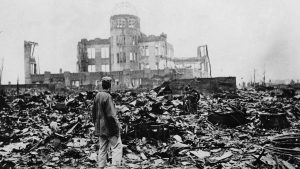What comes to mind when nuclear war is mentioned? The on-off Singapore summit? The shifting dynamic between two volatile leaders, Donald Trump of the United States, the world’s most advanced nuclear power and Kim Jong-un of newly nuclear-capable North Korea? Or the pair’s boasts about their nuclear capability?
All of the above might be expressed in various dramatic genres. There is absurdism, action, black comedy, suspense. What seems to be missing is existential angst. For a world that’s supposed to be trying to avert nuclear catastrophe, we don’t seem overly engaged in discourse about the pending end of our days.
We aren’t obsessively discussing the immediate, day two, year five and quarter century consequences of using a hydrogen bomb, which can be 1,000 times more powerful than the atomic bombs dropped on Japan by the US in 1945.
Those two bombs on Hiroshima and Nagasaki killed more than 200,000 people. A hydrogen bomb could vaporise an entire city. The difference, according to Korean studies professor Andrei Lankov, is as follows: “With an atomic bomb, you can kill half of Manhattan at most. [A hydrogen bomb] could evaporate the entire city of New York completely. No one would stay alive.”
So, why aren’t we more rattled? Why isn’t there more apocalyptic fiction and non-fiction? Why aren’t we on a perpetual “bombing run” these days, to use the term coined by paediatrician Helen Caldicott, chief campaigner for the anti-nuclear movement, to describe her 1980s march through city after city of Ronald Reagan’s America?
With the authority of a medical practitioner and the passion of an evangelist, Dr Caldicott would describe the probable effects of a 1-megaton bomb on the city where she was speaking. She would specify how many people would be burned, crushed, blinded, maimed and irradiated. She was enormously effective.
Hugh Gusterson, an anthropologist who focuses on nuclear culture, once wrote: “As a young activist for the nuclear freeze campaign, I watched the extraordinary effect Caldicott had on audiences, many members of which would silently weep as she spoke.”
This is not to argue for nuclear alarmism. An intense fear of coming nuclear annihilation could hardly be anything but debilitating.
Consider the way the main protagonist in Dirk Kurbjuweit’s bestselling novel Fear recalls his schoolboy terror of a nuclear conflagration in the 1980s: “You didn’t have to know much about the arms race — a single sentence was enough to send shivers down your spine. In a nuclear war nobody escaped alive and it wasn’t even desirable to be spared.…The fear of nuclear warfare was the fear of death and the fear of life.”
Kurbjuweit’s 2013 novel was translated from German to English last year. Interestingly, it evokes the heightened fears of the Cold War era, during the stand-off between evenly matched titans.
After World War II, albeit with some peaks and troughs right up to the mid-1980s, there was pronounced international concern about nuclear war and its devastating consequences.
American psychologists Robert Schatz and Susan Fiske noted an extraordinary change in worry levels over nuclear war in a 1992 paper for Political Psychology journal. By the 1980s, compared to the 1960s, people in the US, UK, Finland and Canada increasingly did not expect to survive nuclear war.
Is there the same sense of doom across much of the western hemisphere today? It seems unlikely, else Mr Trump would hardly be issuing his most recent threat to Mr Kim about America’s “so massive and powerful nuclear capabilities”.
As has been pointed out, this is the first time since 1962 that a US president has threatened direct military action against a nuclear weapon state.
But there are two reasons much of the world seems relatively sanguine. There is a climate of anxiety overload — climate change, plastic pollution, pandemics.
And then there is the abstract nature of the nuclear threat and the distance in time from the last (and only) nuclear attack.
As the late Michael Quinlan, a veteran at the UK’s Ministry of Defence, said: “We have no empirical data beyond 1945 about how events may run if nuclear weapons are used.”
In the circumstances, it becomes harder to remember the suffering of nearly three generations ago.
And it is almost impossible to conjure up so haunting a picture of wipeout as HG Wells did in his 1914 novel The World Set Free about a bomb that would continue to explode indefinitely: “These crowning buds…opened and flared like waterlilies of flame over nations destroyed, over churches smashed or submerged, towns ruined, fields lost to mankind for ever and a million weltering bodies. Was this lesson enough for mankind, or would the flames of war still burn amidst the ruins?”
Shouldn’t we be more anxious?


